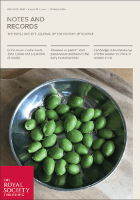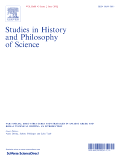
Notes and Records-The Royal Society Journal of the History of Science
Scope & Guideline
Illuminating the Evolution of Scientific Thought
Introduction
Aims and Scopes
- Interdisciplinary Historical Analysis:
The journal publishes research that intersects various fields such as history, philosophy, sociology, and cultural studies, focusing on the evolution of scientific ideas and practices. - Biographical Studies of Scientists:
A significant portion of the journal’s content delves into the lives and contributions of notable scientists, exploring their personal narratives and the socio-historical contexts that shaped their work. - Cultural and Social Context of Science:
Contributions often examine how cultural and social factors influenced scientific thought and practice, emphasizing the interplay between science and society. - Technological and Instrumental Histories:
The journal includes studies on the development and impact of scientific instruments and technologies, providing insights into how these tools shaped scientific inquiry. - Global Perspectives on Science:
The journal encourages submissions that consider scientific developments in a global context, highlighting transnational exchanges and the influence of non-Western scientific traditions.
Trending and Emerging
- Sustainability and Environmental History:
There is an increasing focus on sustainability and environmental history, with studies examining the historical context of scientific practices related to ecology and conservation. - Gender and Science:
Emerging themes include the exploration of gender dynamics within scientific communities, highlighting the contributions of women and the impact of gender on scientific practices. - Transnational and Comparative Studies:
The journal has seen a rise in comparative studies that analyze scientific developments across different cultures, emphasizing the interconnectedness of global scientific traditions. - Cultural Representations of Science:
Research exploring how science is represented in literature, art, and popular culture is gaining traction, reflecting an interest in the broader cultural implications of scientific ideas. - History of Science in Non-Western Contexts:
There is a growing emphasis on the history of science outside the Western canon, with more papers focusing on scientific practices and knowledge systems in Asia, Africa, and Latin America.
Declining or Waning
- Traditional Scientific Disciplines:
There is a noticeable decline in papers centered around traditional scientific disciplines such as physics and chemistry in favor of more interdisciplinary and culturally contextual studies. - Eurocentric Narratives of Science:
The journal seems to be moving away from Eurocentric narratives, with fewer articles focusing solely on European scientific developments without considering global influences. - Conventional Historical Methodologies:
The use of conventional historical methodologies, such as straightforward chronological accounts of scientific achievements, appears to be waning as the journal embraces more innovative and multidisciplinary approaches.
Similar Journals

Journal for General Philosophy of Science
Connecting Ideas in the Philosophy of Science and BeyondJournal for General Philosophy of Science, published by Springer, stands as a pivotal resource in the fields of History and Philosophy of Science, as well as general Philosophy. With an impressive Q1 ranking in its categories and a solid reputation reflected in its Scopus rankings, this journal provides a robust platform for scholarly discourse and advancement in philosophical inquiry regarding science. The journal's commitment to quality is evident, catering to researchers, professionals, and students interested in the critical examination of scientific methods, theories, and their implications. While it operates on a subscription basis, the journal is dedicated to fostering a deeper understanding of philosophical issues surrounding scientific practices from 1980 through 2024. Operating out of the picturesque Netherlands, specifically from VAN GODEWIJCKSTRAAT 30, 3311 GZ DORDRECHT, the journal continues to encourage innovative thinking and interdisciplinary dialogue, underscoring its significance in academia today.

PHILOSOPHY OF SCIENCE
Pioneering Discussions in the Philosophy of SciencePHILOSOPHY OF SCIENCE, published by Cambridge University Press, serves as a premier journal at the intersection of history, philosophy, and science, making significant contributions to our understanding of scientific inquiry and its historical contexts. With an impressive impact factor reflected in its 2023 Category Quartiles—ranking Q1 in History, Q1 in History and Philosophy of Science, and Q1 in Philosophy—this journal stands out as a vital resource for researchers, professionals, and students alike. Operating without Open Access, it encourages the dissemination of groundbreaking ideas from 1949 through 2024, illustrated by its robust Scopus rankings, including a remarkable 98th percentile in the History category. Based in the United Kingdom at the prestigious Cambridge campus, PHILOSOPHY OF SCIENCE is committed to fostering scholarly dialogue and advancing critical thought in the philosophy of science.

European Journal for Philosophy of Science
Pioneering Critical Discussions in the Philosophy of ScienceThe European Journal for Philosophy of Science, published by SPRINGER, stands as a prestigious platform for scholars in the realms of philosophy and history of science. With an impressive impact factor and categorized in the Q1 Quartile for both History and Philosophy of Science and Philosophy, this journal ranks among the top 10% of its peers, reinforcing its critical role in advancing academic discussions and insights within these fields. With its composition of rigorous peer-reviewed articles and a commitment to fostering interdisciplinary dialogue, the journal navigates foundational and contemporary issues that shape scientific inquiry. Although currently not Open Access, it provides invaluable access to researchers, professionals, and students who seek to deepen their understanding of the philosophical underpinnings of scientific practice. Housed in the Netherlands, the journal continuously engages with the evolving landscape of philosophy in the scientific domain, making it a key resource for anyone invested in the intersection of science and philosophy.

STUDIES IN HISTORY AND PHILOSOPHY OF SCIENCE
Unraveling the Philosophical Threads of Scientific EvolutionSTUDIES IN HISTORY AND PHILOSOPHY OF SCIENCE, published by Elsevier Science Ltd, is a leading academic journal dedicated to the exploration of historical and philosophical dimensions of science. With both an ISSN of 0039-3681 and E-ISSN of 1879-2510, this esteemed journal has established itself as a pivotal resource since its inception in 1970 and continues to publish cutting-edge research reflecting the evolution of scientific thought. Situated in the United Kingdom, it is recognized for its high-impact contributions, boasting a Q1 ranking in both History and History and Philosophy of Science categories as of 2023. Researchers in the humanities will benefit from the journal’s rigorous analysis and insightful discussions, as evidenced by its competitive Scopus rankings—placing it in the 96th and 83rd percentiles in their respective fields. Although not an open-access journal, it maintains a commitment to scholarly excellence, aiming to foster a deeper understanding of the interconnections between historical context and philosophical inquiry in the scientific domain, making it an invaluable resource for students, professionals, and researchers alike.

History of science and technology
Connecting the dots between history, culture, and innovation.History of Science and Technology is an esteemed open-access journal published by SUIT Publishing, dedicated to advancing knowledge in the interrelated fields of history, science, technology, and their cultural implications. Since its inception in 2013, this journal has served as a vital platform for researchers, professionals, and students, fostering interdisciplinary dialogue and critical discourse on historical developments in science and technology. With an impressive reputation reflected in its 2023 Scopus rankings, where it ranks in the Q2 and Q3 quartiles across multiple related fields, it has positioned itself as a prominent resource in the academic community. The journal is particularly recognized for its contributions to archeology, museology, and the philosophy of science, making it essential reading for those engaged in these domains. Based in Kyiv, Ukraine, and operating under an open-access model, the History of Science and Technology aims to make high-quality research widely accessible, ultimately enriching the historical narrative and encouraging scholarly engagement across disciplines.

NTM
Pioneering Scholarly Discourse in History and TechnologyNTM is a prestigious academic journal published by SPRINGER INT PUBL AG, dedicated to the field of History, with a focus on the interplay between science, technology, and society. Operating since 1969, NTM has established itself as a significant platform for interdisciplinary scholarship, catering to a diverse audience of researchers, professionals, and students. With an impressive Q2 category ranking in the Arts and Humanities History field, as recognized in 2023 Scopus rankings, it places within the top 77th percentile among its peers, reinforcing its vital role in academic discourse. Although it is not an open-access publication, the journal offers a wealth of scholarly articles, research studies, and critical reviews that contribute to a deeper understanding of the historical contexts that shape contemporary scientific and technological developments. NTM, with its ISSN 0036-6978 and E-ISSN 1420-9144, is a must-read for those seeking to engage with the evolving narratives of history and its implications for today's societal frameworks.

History of Geo- and Space Sciences
Unveiling the past to illuminate the future of planetary sciences.History of Geo- and Space Sciences is a distinguished open-access journal published by COPERNICUS GESELLSCHAFT MBH since 2010, committed to advancing knowledge in the interdisciplinary fields of Earth and planetary sciences as well as the history and philosophy of science. Based in Germany, this journal operates under ISSN 2190-5010 and E-ISSN 2190-5029, providing a platform for researchers, professionals, and students to disseminate and access high-quality scholarly articles. With a remarkable impact reflected in its 2023 Scopus rankings, placing it in Q3 for Earth and Planetary Sciences (miscellaneous) and Q2 for History and Philosophy of Science, the journal plays a crucial role in fostering dialogue and collaboration among the scientific community. It not only covers significant advancements in geo-sciences but also addresses historical perspectives and philosophical inquiries that shape our understanding of the discipline. Engage with groundbreaking research and broaden your insights by contributing to or reading articles from this pivotal journal.

OSIRIS
Cultivating Scholarly Insight in the HumanitiesOSIRIS, published by the University of Chicago Press, is a distinguished journal focusing on the dynamic intersection of Cultural Studies and the Arts and Humanities. With an established history dating back to 1985, the journal has undergone several converged publication years, reflecting its evolution and commitment to addressing contemporary topics in these fields. OSIRIS holds a reputable position with an impact factor that places it in the Q2 category for Cultural Studies and Q3 for Arts and Humanities (miscellaneous) as of 2023, signifying its influence and scholarly contribution. Researchers and academics will appreciate its rigorous peer-reviewed articles, which aim to advance understanding and foster dialogue around critical socio-cultural issues. While OSIRIS does not currently offer open access, it remains a vital resource for those engaged in the pursuit of knowledge across the arts and humanities spectrum, positioning itself as an essential platform for scholarly discourse from its home base in Chicago, United States.

JOURNAL OF THE HISTORY OF BIOLOGY
Charting the Historical Landscape of BiologyJOURNAL OF THE HISTORY OF BIOLOGY, published by Springer, stands as a vital academic resource devoted to examining the historical development of biological science and its philosophical dimensions. This esteemed journal, which has been in continuous publication since 1968 and encompasses research through 2024, is recognized for its significant contributions to the fields of Agricultural and Biological Sciences, and the History and Philosophy of Science, proudly holding a Q2 ranking in both categories as of 2023. With an ISSN of 0022-5010 and an E-ISSN of 1573-0387, it serves a diverse audience of researchers, professionals, and students interested in the interplay between biological advancements and historical context. The journal’s particular emphasis on interdisciplinary investigation provides a platform for innovative scholarship that enriches our understanding of not only the science itself but also its societal implications. While it does not currently offer open access, the rigor and reputation of the journal underscore its importance as a leading publication in the academic landscape of biological history.

PHYSICS IN PERSPECTIVE
Integrating History and Modernity in Physical SciencesPHYSICS IN PERSPECTIVE, published by SPRINGER BASEL AG, is an esteemed journal dedicated to the intricate interplay between the history of physics and its contemporary implications. With an ISSN of 1422-6944 and an E-ISSN of 1422-6960, this journal has established itself as a pivotal resource for researchers, scholars, and students who seek a deeper understanding of physics through a historical lens. The journal enjoys a Q1 ranking in History and a Q3 ranking in Physics and Astronomy (miscellaneous), illustrating its significance in the arts and humanities as well as its notable contributions to physics scholarship. Published in Switzerland, it provides a unique platform for interdisciplinary dialogue, combining historical analysis with modern physics discussions. As it continues to grow through its converged years from 1999 to 2024, PHYSICS IN PERSPECTIVE remains committed to enriching the academic community and fostering innovative research that bridges the past and present of the physical sciences.